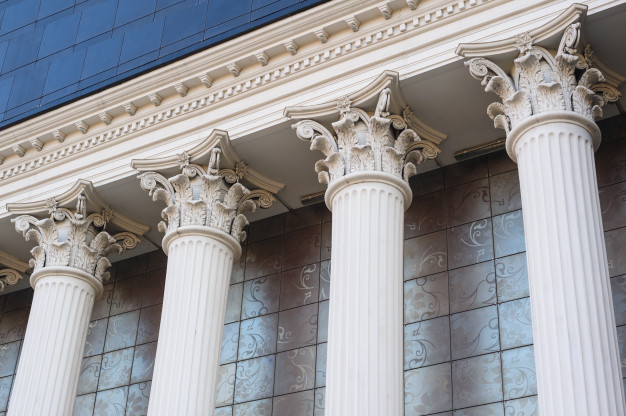Glass Reinforced Concrete (GRC)
About Glass Reinforced Concrete (GRC)
Glassfibre Reinforced Cement ( GRC ) is a composite material consisting of a mortar of cement and fine aggregate reinforced with alkali resistant glassfibre. The GRC may contain additional filler materials, pozzolanic materials and admixtures. The fibre contents are typically 3% to 5% by weight defending on product application and production method employed. The properties of GRC depend on a wide range of variables. These include the method of manufacturing, mix formulation, fibre product type, length and orientation, add mixtures used etc. A GRC material may therefore be tailored to meet the particular requirements of a specific application.
- LIGHTWEIGHT
- STRONG
- CORROSION RESISTANCE
- DESIGN FLEXIBILITY
- DURABLE
- AFFORDABLE
Typical Formulations
| Ingredients | Spray | Premix |
|---|---|---|
| Cement | 50 kg | 50 kg |
| Silica Sand | 50 kg | 50 kg |
| AR Glass fiber | 4.5-5% | 3-4% |
| Superplastisizers | 0.5 kg | 0.5 kg |
| Polymer | 5 kg | 5 kg |
| Water | 13.5 L | 14.5 L |
Typical Strength Properties of GRC
| Property | After 28 days | After Ages |
|---|---|---|
| Density, dry (kg m3) | 1800-2000 | 1800-2000 |
| Impact strength, charpy (Nmm/mm2) | 8-15 | 4-5 |
| Compressive strength, edgewise (MPa) | 40-60 | 50-60 |
| Flexural: | ||
| Yield, TY (MPa) | 5-8 | 7-10 |
| Ultimate strength, FU (MPa) | 10-14 | 10-14 |
| Modulus of elasticity (MPa) | 10 x 103 - 20 x 103 | 18 x 103 - 22 x 103 |
| Direct Tension: | ||
| Yield, TY (MPa) | 4-6 | 4.5-7 |
| Ultimate strength, TU (MPa) | 4-7 | 4.5-8 |
| Strain to failure (%) | 0.1-0.2 | 0.03-0.06 |
| Shear: | ||
| Interlaminar | not available | not available |
| In-plane (MPa) | 4-7 | 4-7 |
| Coefficient of thermal expansion(x 10 ⁶/°C) | 10-18 10-18 | 10-18 |
| Thermal conductivity(W/m.°C) | 0.5-1.0 0.5-1.0 | 0.5-1.0 |
GRC Forms
- All
- Window Surrounds
- Cornices
- Brackets
- Columns
- Capital and Base
- Dome
- Screen and Panel
- Baluster Railings
- Arch
- Landscapings
GRC Benefits
Design Criteria
GRC Design Criteria
An understanding of basic molding and casting constraints of glass fiber reinforced concrete will provide a better understanding for the architect and engineer of how GRC design shapes and forms are to be manufactured. Here are some designs considerations that may affect the cost of GFRC used in your project. GFRC can reproduce intricate details or smooth sweeping curves. Details and undercuts require rubber mold liners. Simple smooth flats and curves can be cast in rigid molds of fiberglass. While rubber molds are slightly more expensive, the cost may be minimal if the casting is repeated several times. Numerous casts of a GFRC shape are more economical per piece, than onetime-only casts. GFRC can be cast in pieces up to 12’ in length. Maximum area 60-80 Sq. Ft & depends on design & thickness. However, the longer the length, the more difficult it is to handle and ship the GFRC casting. We recommend a maximum area 60 to 80 Sq. Ft depends on design & thickness for most moldings. If longer lengths are required, pieces can be field joined.
Quality Assurance
GRC Quality Assurance
The success of any GFRC system depends on a coordinated effort by the designer, manufacturer and installer. Sequence, deliveries and manufacturing tolerances are critical to the success of the project and should be mutually agreed upon by all parties. Submittals and shop drawings should be utilized extensively to familiarize the designer and installer with the method of attachment, reinforcement and fabrication. This process alerts the designer to any possible conflicts. The GFRC shop drawings should be complete in every detail to allow the installing contractor a complete inventory of parts and pieces, as well as expected tolerances.
Conclusion
A properly designed, manufactured and installed GRC system will provide an innovative and visually pleasing appearance, while often reducing overall cost, onsite labor requirements and shortening construction schedules. Glass fiber reinforced concrete (GRC) offers an endless variety of decorative and ornamental shapes and forms at affordable prices. Permeability of GFRC depends on the mix design and compaction and is better than most cementitious materials.













